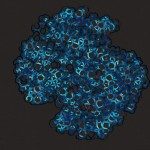Link to Pubmed [PMID] – 22157749
EMBO J. 2012 Feb;31(4):1041-53
In Gram-negative bacteria, type II secretion systems (T2SS) assemble inner membrane proteins of the major pseudopilin PulG (GspG) family into periplasmic filaments, which could drive protein secretion in a piston-like manner. Three minor pseudopilins PulI, PulJ and PulK are essential for protein secretion in the Klebsiella oxytoca T2SS, but their molecular function is unknown. Here, we demonstrate that together these proteins prime pseudopilus assembly, without actively controlling its length or secretin channel opening. Using molecular dynamics, bacterial two-hybrid assays, cysteine crosslinking and functional analysis, we show that PulI and PulJ nucleate filament assembly by forming a staggered complex in the plasma membrane. Binding of PulK to this complex results in its partial extraction from the membrane and in a 1-nm shift between their transmembrane segments, equivalent to the major pseudopilin register in the assembled PulG filament. This promotes fully efficient pseudopilus assembly and protein secretion. Therefore, we propose that PulI, PulJ and PulK self-assembly is thermodynamically coupled to the initiation of pseudopilus assembly, possibly setting the assembly machinery in motion.


